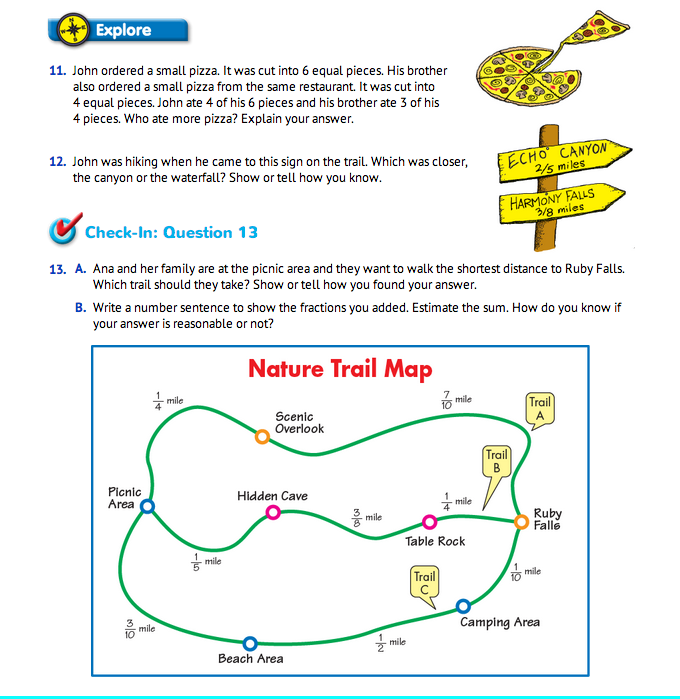Add and Compare Fractions. To summarize the lesson, students complete Check-In: Question 13. Ask students to carefully read the question. Before they solve the problem, display and direct students to the Math Practices page in the Student Guide Reference section. Encourage them to write their solutions so that they meet the following Expectations.
Ask student pairs to discuss the answers to these questions:
- What is the question to answer [MPE1]? (Which trail is the shortest distance to Ruby Falls?)
- Do you think this question requires an exact answer or an estimate? Why? (exact; In order to compare the trail distances, I will need to find the sums of the fractions posted along the trails.)
- What are some ways to find common denominators?
(Possible responses: I can find equivalent fractions that have common denominators using fraction circle pieces, the Fractions on Number Lines Chart, Fraction Chart and Multiplication and Division Facts page in the Student Guide Reference section, and multiplication and division strategies like Jerome did.)
- How can you show or tell how you arrived at your solution [MPE5]? (Possible response: I can show or tell how I found common denominators, and how I used fraction circle pieces or mental math strategies to add the fractions and compare the sums.)
- What labels will you use to show what your numbers mean [MPE6]? (I label distance with miles.)
- How can you check the reasonableness of your answer [MPE3]? (I can estimate the fraction sums to make sure they are all reasonable.)

Use Check-In: Question 13 on the Using Common Denominators pages in the Student Guide and the corresponding Feedback Box in the Teacher Guide to assess students' abilities to find equivalent fractions using fraction circle pieces, number lines, and multiplication and division strategies [E1]; represent addition of fractions with number sentences [E3]; solve word problems involving addition of fractions [E5]; add fractions with unlike denominators using area models and paper-and-pencil methods [E8]; estimate sums of fractions using benchmarks and mental math strategies [E9]; find common denominators and using them to add fractions [E10]; know the problem [MPE1]; find a strategy [MPE2]; check for reasonableness [MPE3]; explain solutions [MPE5]; and use labels [MPE6].
Complete Quiz. Assign the Working with Fractions Quiz Assessment Masters for students to complete individually. Encourage students to use fraction circle pieces, the Finding Equivalent Fractions and Ratios Menu, Fraction Chart, Fractions on Number Lines Chart, and Multiplication and Division Facts pages in the Student Guide Reference section as needed.

Use Working with Fractions Quiz Assessment Masters with the Feedback Box to assess students' abilities to find equivalent fractions using fraction circle pieces, number lines, and multiplication and division strategies [E1]; solve word problems involving addition of fractions [E5]; add and subtract fractions with unlike denominators using area models and paper-and-pencil methods [E8]; estimate sums and differences of fractions using benchmarks and mental math strategies [E9]; find common denominators and using them to add, subtract, and compare fractions [E10]; know the problem [MPE1]; find a strategy [MPE2]; check for reasonableness [MPE3]; explain solutions [MPE5]; and use labels [MPE6].














